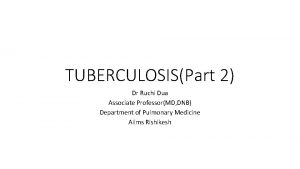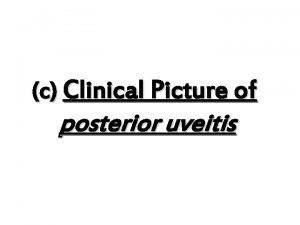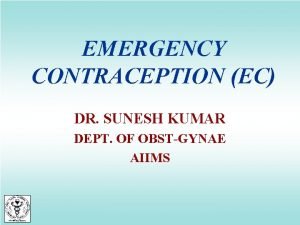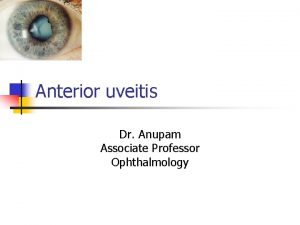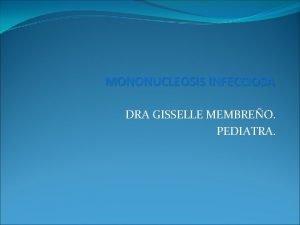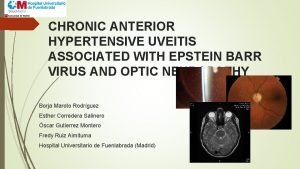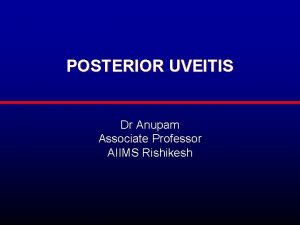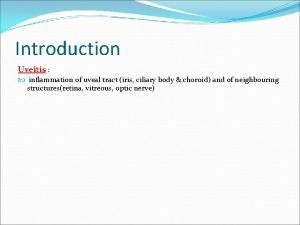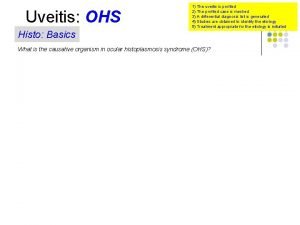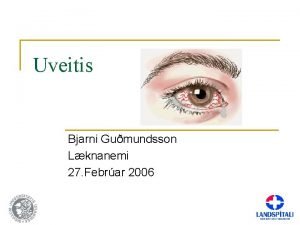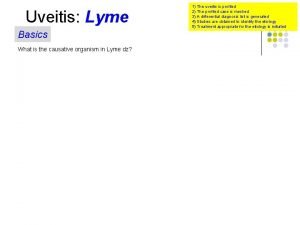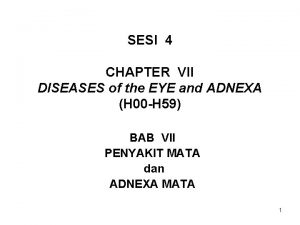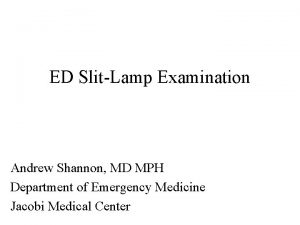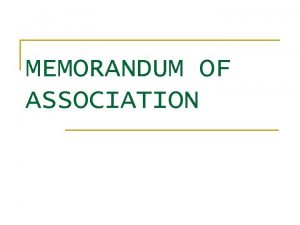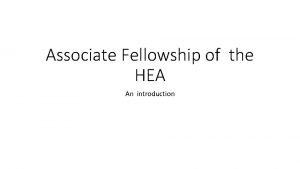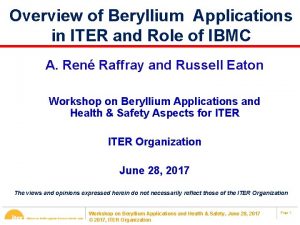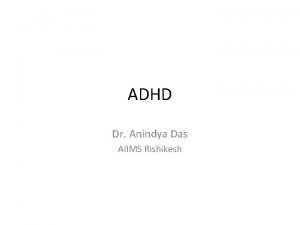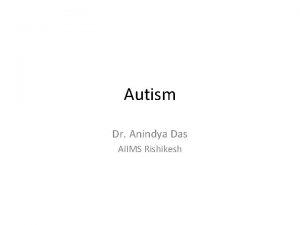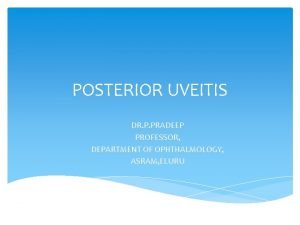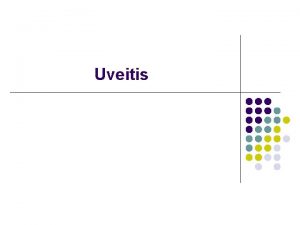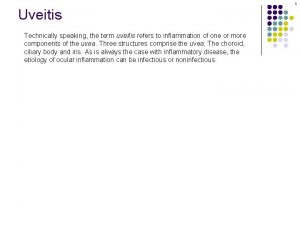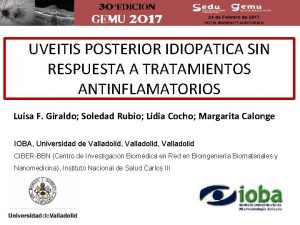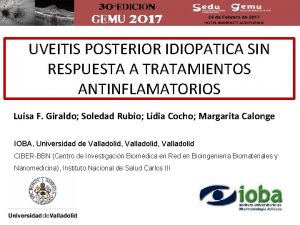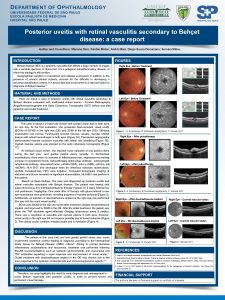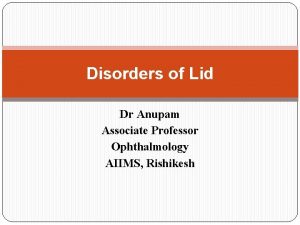POSTERIOR UVEITIS Dr Anupam Associate Professor AIIMS Rishikesh




























































- Slides: 60

POSTERIOR UVEITIS Dr Anupam Associate Professor AIIMS Rishikesh

Definition & Classification of Uveitis • Inflammation of uveal tract is uveitis. • CLASSIFICATION: • • I. ANATOMICAL CLASSIFICATION II. CLINICAL CLASSIFICATION III. ETIOLOGICAL CLASSIFICATION IV. PATHOLOGICAL CLASSIFICATION

A. Anatomical Classification – (IUSG) International Uveitis Study Group 1) Anterior Uveitis – Inflammation of iris and anterior part of ciliary body. 2) Intermediate Uveitis – Involvement of posterior part of ciliary body and extreme periphery of retina. (Pars planitis) 3) Posterior uveitis – Retinochoroiditis, retinitis, chorioretinitis 4) Diffuse or pan uveitis – Involvement of entire uveal tract

B. Clinical Classification • 1) Acute – sudden symptomatic onset. Persists for 3 weeks or less. • 2) Chronic – Frequently insidious and asymptomatic. Persists for months or years. • 3) Recurrent

C. Etiological Classification • 1) Exogenous. Introduction of organism into the eye through a perforating wound or ulcer. Acute iridocyclitis of suppurative type, panophthalmitis. • 2) Secondary infection- Due to direct spread from adjoining structures— Cornea — Sclera — Retina

D. Pathological Classification 1) Granulomatous 2) Non-granulomatous

POSTERIOR UVEITIS • Posterior uveitis refers to inflammation of the choroid (choroiditis). • Since the outer layers of retina are in close contact with the choroid and also depend on it for the nourishment, the choroidal inflammation almost always involves the adjoining retina and the resultant lesion is called chorioretinitis.

Clinical types • I. Suppurative choroiditis (Purulent inflammation of the choroid) • • II. Non-suppurative choroiditis 1. Diffuse choroiditis. 2. Disseminated choroiditis. 3. Circumscribed/localised/focal choroiditis. i. Central choroiditis. ii. Juxtacaecal or juxtapapillary choroiditis. iii. Anterior peripheral choroiditis. iv. Equatorial choroiditis.

Symptoms • • 1. Defective vision. 2. Photopsia. 3. Black spots floating in front of the eyes. 4. Metamorphopsia. 5. Micropsia 6. Macropsia 7. Positive scotoma

Signs • 1. Vitreous opacities • 2. Features of a patch of choroiditis. i. In active stage it looks as a pale-yellow or dirty white raised area with ill-defined edges. This results due to exudation and cellular infiltration of the choroid which hide the choroidal vessels. The lesion is typically deeper to the retinal vessels. The overlying retina is often cloudy and oedematous.


Signs • ii. In atrophic stage or healed stage, when active inflammation subsides, the affected area becomes more sharply defined and delineated from the rest of the normal area. The involved area shows white sclera below the atrophic choroid and black pigmented clumps at the periphery of the lesion.

Complications These include extension of the inflammation to anterior uvea, complicated cataract, vitreous degeneration, macular oedema, secondary periphlebitis retinae and retinal detachment.

Treatment • It is broadly on the lines of anterior uveitis. • 1. Non-specific therapy: In the form of topical and systemic steroids. • 2. Specific treatment is required for the causative disease.

PURULENT UVEITIS • Purulent uveitis is suppurative inflammation of the uveal tract occurring as a result of direct invasion by the pyogenic organisms. • • Purulent iridocylitis Purulent choroiditis Endophthalmitis Panophthalmitis

ENDOPHTHALMITIS • Endophthalmitis is defined as an inflammation of the inner structures of the eyeball i. e. , uveal tissue and retina associated with pouring of exudates in the vitreous cavity, anterior chamber and posterior chamber. • Etiologically endophthalmitis may be infectious or non-infectious (sterile).

A. Infective endophthalmitis • Exogenous infections. • Endogenous or metastatic endophthalmitis. • Secondary infections from surrounding structures.

Causative organisms • 1. Bacterial endophthalmitis. S. epidermidis and S. aureus, Streptococci, Pseudomonas, Pneumococci, Cornebacterium.

Propionio bacterium acnes and actinomyces are gram-positive organisms capable of producing slow grade endophthalmitis. • 2. Fungal endophthalmitis is caused by aspergillus, fusarium, candida etc.

B. Non-infective (sterile)endophthalmitis • Sterile endophthalmitis refers to inflammation of inner structures of eyeball caused by certain toxins/toxic substances. It occurs in following situations. • 1. Postoperative sterile endophthalmitis • 2. Post-traumatic sterile endophthalmitis • 3. Intraocular tumour • 4. Phacoanaphylactic endophthalmitis

Symptoms. • Acute bacterial endophthalmitis usually occurs within 7 days of operation and is characterized by severe ocular pain, redness, lacrimation, photophobia and marked loss of vision.

Signs • Lid swelling • Conjunctival chemosis and congestion • Corneal edema • Wound gape & necrosis • Hypopyon • Iris becomes edematous and muddy • Yellow reflex • IOP may or may not be raised

Treatment • Intravitreal antibiotics , S/C injections, Topical fortified antibiotic drops & oral antibiotics. • Cycloplegics • Antiglaucoma therapy • Vitrectomy

PANOPHTHALMITIS • It is an intense purulent inflammation of the whole eyeball including the Tenon’s capsule. • • • Symptoms. Severe ocular pain and headache Complete loss of vision Watering & discharge Marked redness and swelling of the eyes

Signs • Lids swelling. • Eyeball is slightly proptosed, ocular movements are limited & painful. • Ciliary as well as conjunctival congestion. • Cornea is cloudy and oedematous. • Anterior chamber is full of pus. • Vision is completely lost • Intraocular pressure is markedly raised.

• Complications include • Orbital cellulitis • Cavernous sinus thrombosis • Meningitis or encephalitis

Treatment • 1. Anti-inflammatory and analgesics • 2. Broad spectrum antibiotics • 3. Evisceration

Non-suppurative Uveitis • I. UVEITIS ASSOCIATED WITH CHRONIC SYSTEMIC BACTERIAL INFECTIONS: 1. Tubercular uveitis 2. Syphilitic uveitis 3. Leprotic uveitis • UVEITIS ASSOCIATED WITH NONINFECTIOUS SYSTEMIC DISEASES 1. Uveitis in sarcoidosis 2. Behcet’s disease.

Non-suppurative Uveitis • III. UVEITIS ASSOCIATED WITH ARTHRITIS 1. Uveitis with Ankylosing spondylitis 2. Reiter’s syndrome 3. Still’s disease • IV. PARASITIC UVEITIS 1. Toxoplasmosis 2. Toxocariasis 3. Onchocerciasis 4. Amoebiasis

Non-suppurative Uveitis • V. FUNGAL UVEITIS 1. Presumed ocular histoplasmosis syndrome 2. Candidiasis • VI. VIRAL UVEITIS 1. Herpes simplex uveitis 2. Herpes zoster uveitis 3. Acquired cytomegalovirus uveitis 4. Uveitis in acquired immune deficiency syndrome (AIDS)

Non-suppurative Uveitis • VII. LENS INDUCED UVEITIS 1. Phacotoxic uveitis 2. Phacoanaphylactic endophthalmitis • VIII. TRAUMATIC UVEITIS • IX. UVEITIS ASSOCIATED WITH MALIGNANT INTRAOCULAR TUMOURS

Non-suppurative Uveitis • IDIOPATHIC SPECIFIC UVEITIS SYNDROMES 1. Fuchs’ uveitis syndrome 2. Intermediate uveitis (pars planitis) 3. Sympathetic ophthalmitis 4. Glaucomatocyclitic crisis. 5. Vogt-Koyanagi-Harada’s syndrome. 6. Bird shot retinochoroidopathy. 7. Acute multifocal placoid pigment epitheliopathy (AMPPE) 8. Serpiginous choroidopathy.

VOGT-KOYANAGI-HARADA (VKH) SYNDROME • It is an idiopathic multisystem disorder which includes cutaneous, neurological and ocular lesions, more common in Japanese who are usually positive for HLADR 4 and DW 15. • Clinical features • 1. Cutaneous lesions include: alopecia, poliosis and vitiligo. • 2. Neurological lesions are in the form of meningism, encephalopathy, tinnitus, vertigo and deafness. • 3. Ocular features are bilateral chronic granulomatous panuveitis and exudative retinal detachment. • Treatment. It comprises steroids administered topically, periocularly and systemically.

SYMPATHETIC OPHTHALMITIS • It is a rare bilateral granulomatous panuveitis. • Occurs following penetrating ocular trauma associated with incarceration of uveal tissue in the wound. • The injured eye is called ‘exciting eye’ and the fellow eye which also develops uveitis is called ‘sympathizing eye’.

• A. Predisposing factors • 1. It almost always follows a penetrating wound. • 2. Wounds in the ciliary region • 3. Wounds with incarceration of the iris, ciliary body or lens capsule are more vulnerable. • 4. It is more common in children than in adults. • 5. It does not occur when actual suppuration develops in the injured eye.

• Dalen-Fuchs’ nodules are formed due to proliferation of the pigment epithelium (of the iris, ciliary body and choroid) associated with invasion by the lymphocytes and epitheloid cells.

Clinical picture • I. Exciting (injured) eye. It shows clinical features of persistent low grade plastic uveitis, which include ciliary congestion, lacrimation and tenderness. • 2. Sympathizing (sound) eye. It is usually involved after 4 -8 weeks of injury in the other eye. Can occur upto 1 year after injury.

• Retrolental flare is first clinical sign. • If not prevented loss of sight is inevitable • Prophylaxis • Treatment.

Ocular Toxoplasmosis Clinical features Unilateral focal chorio-retinitis adjacent to healed chorioretinal scar a. Healed scars may be multiple, but usually only one reactivates at a time. b. Atypical forms of extensive chorio-retinitis can occur in immunocompromised individuals. c. Active chorio-retinitis is yellow-white, slightly elevated, with a relatively well-defined border.

Clinical features: Intraocular inflammation a. Iritis. Often granulomatous & may be associated with ocular hypertension b. Vitritis. Often intensified over the lesion c. Vasculitis. Variably present; Often arteritis, but also periphlebitis and the vasculitis can be remote from the chorio-retinitis d. Optic neuritis or neuro-retinitis.

Appropriate Laboratory Testing 1. Conformation of exposure to toxoplasmosis by serum ab. titer; high sensitivity and low specificity because of high prevalence of positive antibody titers in general population 2. Determination of toxoplasmosis Ig. G or Ig. A titers in aqueous humor useful in cases with atypical features 3. PCR of aqueous humor for toxoplasmosis DNA useful in older patients with large lesions or in immunocompromised patients

Risk of congenital infection Acquired toxoplasmosis infection in a pregnant woman a. Most severe effects on fetus if acquired during first trimester b. Risk of transmission greatest if acquired during third trimester Seroconversion treated with antibiotic therapy Prenatal treatment reduces fetal effects.

Differential Diagnosis 1. Toxocariasis 2. Cytomegalovirus retinitis 3. Necrotizing herpetic retinitis 4. Syphilis 5. Focal fungal or bacterial infections 6. Intraocular lymphoma

Treatment Decision to treat based on proximity to macula and optic nerve, amount of inflammation, and vision 1. Sight-threatening infections almost always treated. 2. Small, peripheral lesions often observed. 3. Infection is self-limited in most cases in healthy patients.

Treatment 1. Pyrimethamine is most common agent combined with sulfadiazine or triple-sulfa, azithromycin, or clindamycin Usually given with leukovorin to mitigate hematologic toxicity 2. Trimethoprim-sulfamethoxazole increasing in use combined with clindamycin for increased efficacy 3. Monotherapy-generally reserved for non-sight threatening disease; Doxycycline or minocycline

Anti-inflammatory Treatment Topical corticosteroids Oral corticosteroids Indicated for vision threatening inflammation Low to moderate doses for 2 to 3 weeks Not given alone because of risk of worsened infection without antibiotic coverage Periocular steroids felt to be contraindicated because of reports of uncontrolled infection after injection Generally not used in immunocompromised patients

INTERMEDIATE UVEITIS (PARS PLANITIS) • It denotes inflammation of pars plana part of ciliary body and most peripheral part of the retina. • Etiology. It is an idiopathic disease usually affecting both eyes of young adults. • Symptoms. Most of the patients present with history of floaters. Some patients may come with defective vision due to associated cystoid macular oedema.

Signs • Fundus examination with indirect ophthalmoscope reveals the whitish exudates present near the ora serrata in the inferior quadrant. These typical exudates are referred as snow ball opacities. These may coalesce to form a grey white plaque called snow banking.

Complications • Cystoid macular oedema, • Complicated cataract and • Tractional retinal detachment • Treatment 1. Corticosteroids ( Topical or systemic) 2. Immunosuppressive drugs may be helpful in steroid resistant cases. 3. Peripheral cryotherapy is also reported to be effective.

MCQ 1. A 60 yr old female having h/o cataract surgery 1 yr back. She had complain of sudden onset painful diminution of vision and was diagnosed as a case of late onset endophthalmitis. Organism most commonly implicated is? • A. Pseudomonas aeruginosa • B. Staphylococcus epidermidis • C. Candida albicans • D. Propionibacterium acnes

MCQ 2. All of the following are involved in endophthalmitis except? • A. Retina • B. Vitreous • C. Sclera • D. Uvea

MCQ • 3. A 30 yr old female had complains of floaters with blurring of vision. On indirect ophthalmoscopy pt had clear central fundus but there was inflammation of the pheripheral part. What is your diagnosis? • • A. Panuveitis B. Posterior uveitis C. Endophthalmitis D. Pars planitis

MCQ • 4. A 50 yr old female having h/o cataract surgery 1 week back. She had complains of sudden onset painful diminution of vision, redness & watering. On clinical examination she had hypopyon, AC cells and flare with vitreous exudates on USG. What is your diagnosis? • A. Panuveitis • B. Posterior uveitis • C. Endophthalmitis • D. Panophthalmitis •

MCQ • 5. A 30 yrs old male had history of trauma followed by loss of vision, severe pain, redness and watering. On clinical examination he had inflammation of all ocular structures including tenon’s capsule. What is your diagnosis? • A. Panuveitis • B. Posterior uveitis • C. Endophthalmitis • D. Panophthalmitis

MCQ • 6. A 50 yr old female having h/o cataract surgery 1 week back. She had complains of sudden onset painful diminution of vision, redness & watering. On clinical examination she had hypopyon, AC cells and flare with vitreous exudates on USG. Which is the most common organism responsible for the condition? • • A. Pseudomonas aeruginosa B. Staphylococcus epidermidis C. Candida albicans D. Propionibacterium acnes

MCQ • 7. A 15 yrs old male had history of penetrating trauma to right eye followed by loss of vision, severe pain, redness and watering in the left eye 3 months after trauma. On clinical examination he retrolental flare with signs of panuveitis. What is your diagnosis? • A. Sympathetic ophthalmitis • B. Posterior uveitis • C. Endophthalmitis • D. Panophthalmitis

MCQ • 8. What is the most common cause of loss of vision in pars planitis? • • A. Panuveitis B. Posterior uveitis C. Cystoid macular edema D. Floaters

MCQ 9. Snow banking is seen in: A. Panuveitis B. Posterior uveitis C. Endophthalmitis D. Pars planitis

MCQ • 10. Dalen-Fuchs’ nodules are seen in: • • A. Sympathetic ophthalmitis B. Posterior uveitis C. Endophthalmitis D. Panophthalmitis

THANK YOU
 Dr ruchi dua
Dr ruchi dua Promotion from associate professor to professor
Promotion from associate professor to professor Occlusio pupillae definition
Occlusio pupillae definition Dr sunesh kumar aiims
Dr sunesh kumar aiims Aiims 2017 manual download
Aiims 2017 manual download Www ehospital gov in
Www ehospital gov in Dr neena khanna aiims
Dr neena khanna aiims Anupam ameya supercomputer
Anupam ameya supercomputer 18734 cmu
18734 cmu Anupam saxena
Anupam saxena Me 251
Me 251 Anupam saxena
Anupam saxena Keratic precipitates
Keratic precipitates Nodulos de koeppe y busacca
Nodulos de koeppe y busacca Imdirecta
Imdirecta Hypertensive uveitis
Hypertensive uveitis Crisis glaucomatocicliticas
Crisis glaucomatocicliticas Retrolental flare definition
Retrolental flare definition Dermatomyocytis
Dermatomyocytis Behcet's disease
Behcet's disease Granulomatous vs non granulomatous
Granulomatous vs non granulomatous Uveitis
Uveitis Lithimnubólga
Lithimnubólga Pizza pie appearance retina
Pizza pie appearance retina Fungal uveitis
Fungal uveitis Festooned pupil meaning
Festooned pupil meaning Uveitis
Uveitis Icd 10 miopia
Icd 10 miopia Kode diagnosis uveitis
Kode diagnosis uveitis Uveitis
Uveitis Granulomatous uveitis
Granulomatous uveitis Merits and demerits of direct mapping
Merits and demerits of direct mapping Name something you associate with superman
Name something you associate with superman To associate
To associate Associate program
Associate program Associate degree rmit
Associate degree rmit Physician associate lecturer
Physician associate lecturer The pyramid at chichen itza is most closely associate with
The pyramid at chichen itza is most closely associate with Doctrine of ultra vires
Doctrine of ultra vires Associate warden
Associate warden Harper college
Harper college Los angeles harbor college admissions
Los angeles harbor college admissions Cern pjas
Cern pjas Child development matrix
Child development matrix Hea associate fellowship
Hea associate fellowship Associate consultant in capgemini
Associate consultant in capgemini Adobe spark certificate
Adobe spark certificate Rcog eportfolio
Rcog eportfolio Lone star college nursing program prerequisites
Lone star college nursing program prerequisites Marine corps league uniform regulations
Marine corps league uniform regulations Customer kpi
Customer kpi It is an active process of discovery
It is an active process of discovery Associate degree pie
Associate degree pie Bcs professional member
Bcs professional member Mhp associate partner gehalt
Mhp associate partner gehalt Associate consultant in capgemini
Associate consultant in capgemini Cincinnati state associate degrees
Cincinnati state associate degrees Rekenhulp tegemoetkoming scholieren
Rekenhulp tegemoetkoming scholieren Iter project associate
Iter project associate Certified systems engineering professional
Certified systems engineering professional Cipd
Cipd
